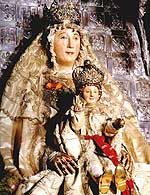The sculptural decoration is Plateresque and was carried out by Pedro de Campos and Lorenzo de Bao, who are also responsible for the figures of the kings, the relief of Isaiah`s Vision above the High Altar, the angels adorming the scallops in the apse and the frieze around the chapel.
On the sides of the apse there are niches with sculptures representing Las Santas Justa y Rufina, San Leandro and San isidoro, St Luke and St John, St Matthew and St Mark as well as St Peter and St Paul. They were sculpted by Diego de Pesquera with the help of Juan Marin between 1571 and 1574.
The sepulchres in the recesses of the side walls in the chapel contain the remains of Alfonso X el Sabio (=the Wise) and of his mother Doña Beatriz de Suabia. The architectural framework of these sepulchres is Plateresque dating from around 1570. The sculptures of the two monarchs are modern. The king´s is by the sculptors Antonio Cano and Carmen jiménez, and that of his nother by Juan Luis Vasallo. Both date from 1948.
The reredos of the Royal Chapel was built by the sculptor Luis Ortiz de Vargas between 1643 and 1649. Under a silver baldacchino the image of La Virgen de los Reyes with the Child on her knees is venerated in the main niche of the reredos. Both figures are 13C Gothic, probably from a French workshop or of the Castilian school with great French influence. This sculpture has a wooden mechanism inside which in the past used to move the head and hands of both figures. The sculptures on the sides of the reredos are St Joachim and St Ann Dating from 1649.
The silver antependia of the altar of La Virgen de los Reyes are Baroque and of exceptional quality. The one in the centre was carried out by Juan Laureano de Pina in 1719 and was reformed by José de Villaviciosa in 1739. The ones on the sides carry the mark of the silversmith Dominguez and are dated 1739.
In front of the altar of La Virgen de los Reyes there is a gilded-silver and crystal urn with the incorruptible body of San Fernando. Its author is Juan Laureeano de Pina who started it in 1690. The antependium is also made of silver and covers the altar with the urn on top. It carries the mark of the silversmiths Resiente and Villaviciosa.
On either side of this altar there are stairs leading to the crypt which is used as a Royal Pantheon where the remains of various members of the Spanish royal family are laid to rest, among them Pedro I of Castile and his wife Maria de Padilla.
In this crypt there is a magnificent ivory sculpture on a small altar.
It represents The Virgin with Child and is also known as The Virgin of Battles because it is said that Fernando III el Santo (=the Saint) carried her with him in all his battles with the Muslims. It is a 13C French work of art.
In the chapel on the left-hand side there is a small reredos built by Juan de Torres in 1648. It has a sculpture of the Ecce Homo signed by Francisco Terrili. From this chapel the Assembly Room is reached where valuable objects connected with San Fernando, among them his sword, are kept in several display cabinets. Different gold and silver items round off this treasure. On the walls there are a picture of San Fernando, A copy of the original by Murillo which is also kept in the Cathedral, a Pietá, also a copy of Murillo´s, La Virgen de los Reyes and St Joseph with a Garland of Flowers, the last two dating from the end of the 17C. On the tribune above this chapel there is a neo-Classical organ built by Antonio Otin Calvete in 1807.
In the right-hand wall there is another small chapell with a small reredos which was built by Luis de Figueroa in 1638 and has a sculpture of St Antony. The choir stalls and the lectern date from the second half of the 18C and were donated by Carlos IV. The painting of St Sebastian attended by St Irene is a 17C copy of an original by Francisco Barbieri, el Guercino. In the sacristy there is a good series of paintings which depict San Fernando`s Entry into Seville, from the end of the 17C, The Annunciation and The Flight to Egypt, both dating from the first quarter of the 18C.
At the exit of the Royal Chapel and the back wall of the Main Chapel there are several paintings, some of them of great interest, such as La Apoteosis de la Inmaculada by Francisco de Herrera el Joven (=the Younger) who painted it in 1656; it is the property of La Hermandad Sacramental del Sagrario, a brotherhood. On its left are The Soldiers of Gideon by an unknown artist from the second half of the 17C, and above, two paintings by Sebastian de Llanos Vades depicting St John before the Sanhedrim and The calling of St Matthew; both are signed and dated 1668.
|




